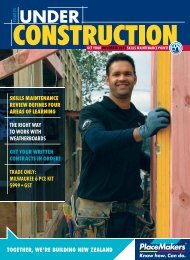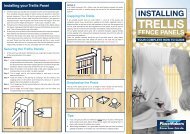what we learned from christchurch taking the risk out ... - PlaceMakers
what we learned from christchurch taking the risk out ... - PlaceMakers
what we learned from christchurch taking the risk out ... - PlaceMakers
Create successful ePaper yourself
Turn your PDF publications into a flip-book with our unique Google optimized e-Paper software.
FEATURESMBIE – BUILDING & HOUSINGDirecting house repairs and rebuildsGuidance for rebuilding and repairing houses in <strong>the</strong> Canterbury green zone hasbeen updated and brought toge<strong>the</strong>r in one folder, making it easier to navigateTechnical guidance was originallycreated in 2011 to support <strong>the</strong>Canterbury rebuild and reflect <strong>the</strong>scale and effects of liquefaction. Itgives technical advice on foundationsfor houses in <strong>the</strong> Canterbury greenzone; structural repairs; assessingearthquake damage to hillsideproperties and retaining walls;and guidelines for subdivisions.Properties in <strong>the</strong> flat areas of <strong>the</strong>Canterbury green zone <strong>we</strong>re dividedinto three Technical Categories (TCs),according to <strong>the</strong> level of investigationand <strong>the</strong> appropriate foundationsrequired for each site. This helpeddirect scarce engineering resourcesto areas of greatest need.For <strong>the</strong> benefit of readers <strong>from</strong><strong>out</strong>side of Canterbury, <strong>the</strong> TCs <strong>we</strong>rebased on area-wide land damageand house damage assessmentsduring <strong>the</strong> earthquake sequenceand known sub-surface geotechnicalconditions.The TC categories are:TC1: Liquefaction damage is unlikelyin future large earthquakes. Standardresidential foundation assessmentand construction is appropriate.TC2: Liquefaction damage is possiblein future large earthquakes. Standardenhanced foundation repair and rebuildoptions, <strong>out</strong>lined in <strong>the</strong> MBIE guidance,are suitable.TC3: Liquefaction damage is possiblein future large earthquakes. Individualengineering assessment is neededto select <strong>the</strong> appropriate foundationrepair or rebuild option.The December 2012 updates focuson repairs to damaged foundations,new foundation options, superstructurerepairs and subdivisions.There is now updated guidance on repairing and replacing wall bracing elements and significant wall damageFOUNDATION OPTIONSSome guidance on TC1 and TC2foundation options has been clarifiedand <strong>the</strong>re are new options for TC3.Guidance on deep pile foundationshas been updated, and revised pilehead details for deep timber, concreteand steel piles are included. Theguidance lists <strong>the</strong> criteria that need tobe met when using a deep piled raft.ASSESSING DAMAGE TOFOUNDATIONSThe first task for a building professionalor engineer is to assess <strong>the</strong> extentof damage to foundations damagedby earthquakes and consider whe<strong>the</strong>rfoundations can be re-leveled andrepaired, or must be rebuilt.MBIE’s guidance says <strong>the</strong>re are threeaspects to consider:• Whe<strong>the</strong>r <strong>the</strong> building has settled bydifferent amounts over its floor, and/or is tilting.• Whe<strong>the</strong>r <strong>the</strong> foundations have been‘stretched’.• Damage to specific parts of <strong>the</strong>foundations.These aspects must be consideredin relation to each o<strong>the</strong>r. Re-levels orrebuilds are triggered by excessivedifferential settlements or floor stretches.If <strong>the</strong> building has settled excessively, <strong>the</strong>foundations may need to be rebuilt, evenif damage to <strong>the</strong> piles or <strong>the</strong> slab doesnot exceed certain limits. If <strong>the</strong>re are cracksin <strong>the</strong> perimeter wall of <strong>the</strong> foundations,but <strong>the</strong> building hasn’t settled, it may bepossible to repair <strong>the</strong> foundations.If <strong>the</strong> slope of <strong>the</strong> floor bet<strong>we</strong>en two pointsmore than 2 m apart is more than 0.5%(10 mm over 2 m), or <strong>the</strong> variation in levelover <strong>the</strong> floor plan is more than 50 mm, itindicates <strong>the</strong> floor or foundation probablyneeds to be re-leveled or possibly rebuiltdepending on <strong>the</strong> degree of tilt.Cracks in ceramic floor tiles and distressin vinyl floor coverings and carpet areo<strong>the</strong>r indicators. Even if <strong>the</strong>se limits arenot exceeded, floor and superstructurerepairs may be required.6www.mbie.govt.nz
















